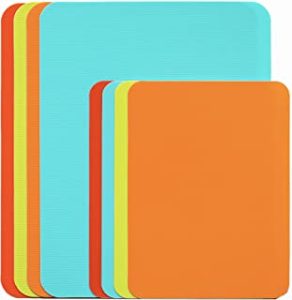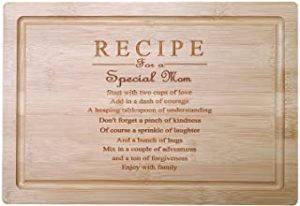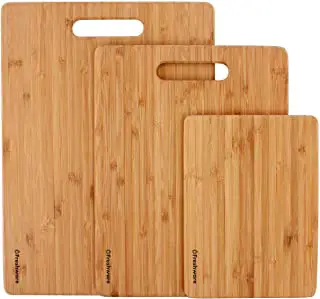Almost every household has a chopping board / cutting board in its kitchen. This kitchen equipment is helpful in preparing meals.
Cutting boards provide a flat and ideal surface to cut your vegetables and fruits and even meats. They increase efficiency to the cutting process and also promote safety. This is because they reduce the risk of cuts caused by cutting items while holding them on your hand.
Today, there are numerous types of cutting boards. Regardless of the type of chopping board, homeowners should take good care of them by ensuring they are well washed and dried after every use.
Whenever you leave your kitchen chopping board in bad shape by failing to keep it clean and store it appropriately, there are high chances that micro-organisms can grow on it. In turn, your food would be unsafe for human consumption.
So, how do you clean and maintain a chopping board?
General cleaning and maintenance of cutting boards
The cleaning tips for cutting boards may vary depending on the type of material the chopping board is made from.
For istance, wooden cutting boards absorb water easily, so you should avoid soaking them in water for long and apply extra steps to ensure they dry fully before storage.
So how do you go about cleaning cutting boards of different materials?
Cleaning and handling plastic cutting boards
No products found.
One of the common types of chopping board is the plastic cutting board. Plastic cutting boards are less expensive but have less durability. But they are safer to use since they do not take in moisture.
Unlike wooden chopping boards, plastic chopping boards are not resistant to scratches and cracks. If you exert too much pressure on them, they are likely to wear and tear more quickly.
Scratches that occur in plastic cutting boards can serve as a habitat for microorganisms. Consequently, they can pose a danger to your health caused by food contamination.

Step by step process of cleaning a plastic chopping board
Luckily, you can wash plastic chopping boards using regular dishwashers. They are not as fragile as wooden chopping boards. Thus, they can withstand high pressure from the dishwasher.
However, it is always advisable to hand wash your plastic chopping board. This way, you prolong its lifespan. When washing your plastic chopping board, follow the steps below:
- When cleaning a plastic cutting board, the first step would be to gently scrub off the board using a soft cloth soaked in warm water with bleach.
- As you scrub you plastic chopping board, pay attention to all the areas that contain stubborn particles.
- Afterward, use plain cold water to rinse the plastic chopping board.
- Then, use a dry cloth to get rid of the water on the cutting board.
Dealing with stains on a plastic chopping board
Occasionally, your plastic chopping board can develop stains due to grease and food particles.
Use a mixture of water, salt, and baking soda to eliminate stains on your plastic chopping board. Also, in case you notice a loose surface on the chopping board, scrub it gently using a scouring pad.
Cleaning a plastic chopping board won’t cost you a lot of time or even money. All you have to do is spare some time to ensure the plastic chopping board is cleaned well after every use.
Cleaning wooden chopping boards
No products found.
One of the most popular types of chopping board is the wooden cutting board. Not only do wooden chopping boards offer great aesthetics, but they are also user-friendly.
Besides, homeowners can use wooden chopping boards to serve food for their guests or family. Moreover, wooden chopping boards are highly resistant to cracks and scratches compared to plastic chopping boards.
Even so, there are a few things you have to incorporate when cleaning wooden chopping boards.
Wash your wooden chopping board regularly
Unlike other utensils, you should manually wash wooden cutting boards regularly. You should not use standard dishwashers to clean your wooden chopping board. Otherwise, you risk damaging both the dishwasher and the cutting board.
Good cleaning and maintenance of your cutting board will give it a longer life, including allowing you to put it to good use, through recycling of the cutting board.

Follow the following steps in cleaning your wooden cutting board:
- Use a soft microfiber cloth or sponge soaked in warm water and detergent to scrub the chopping board gently.
- Pay attention to the sides and any grooves on your cutting board. Here, food particles and bacteria tend to accumulate.
- After washing your wooden chopping board, rinse it properly using cold water.
- Then, leave it to dry for at least fifteen minutes or use a dry cloth to get rid of all moisture on the chopping board.
- Note that you would rather dry your wooden chopping board immediately. Otherwise, it can develop cracks due to excess water absorption.
- Do not store your chopping board while it has traces of moisture.
- Also, ensure that you wash your wooden chopping board after each use. This prevents discoloration and absorption of smells and water especially with wooden cutting boards and promotes longevity of your cutting board.
Seasoning a wooden chopping board
Wooden chopping boards tend to absorb moisture since they are porous. As a result, their composition gets damaged quickly. The water that your wooden chopping board will absorb depends on the climatic condition of your area.
Also, wooden chopping boards can absorb water and also odors from the various foods that you chop on them. For instance, the board can take in juices from fruits and vegetables or the juices or blood from meat.
If you live in areas experiencing high humidity levels, then your wooden chopping board will likely absorb a lot of water. What happens when a wooden chopping board takes in too much moisture?
Well, wooden chopping boards that have high moisture content in them tend to expand. As a result, the cutting board will experience cracks.
Furthermore, too much water in a wooden chopping board can lead to rotting and discoloration and bad odors as a result.
So, make sure you safeguard your wooden chopping board from moisture. Always dry it completely after washing procedures.
Alternatively, seasoning a wooden chopping board can help you protect it from moisture. See the below steps to undertake when seasoning your wooden chopping board.
First, note that seasoning your wooden chopping board’s sole objective is to ensure the wooden chopping board occupies all the extra space that could get accumulated by other liquids. In turn, the wooden chopping board won’t have room to absorb any other moisture or liquids.
No products found.
Maintenance practices to observe when dealing with a kitchen chopping board
- It would be best if you hand-washed all your chopping boards. Avoid using dishwashers to clean your chopping boards. The constant exposure to heat and water is not good for your chopping board. You can cause wear and tear to the chopping board just by washing it using a dishwasher.
- Do not soak your chopping board in water for a long time. In particular, wooden chopping boards tend to take up moisture and experience cracks.
- Avoid using harsh chemicals and bleach to wash your chopping boards. Harsh detergents lead to discolorations and cracks on your wooden chopping board. If possible, use warm water with mild dishwashing soap. For stain removal, use baking soda.
- You can also use sanitize your cutting board using natural cleaning and sanitizing products such as lemon or salt in place of cleaning commercial kitchen disinfectants / detergents or dish soap that can sometimes leave an aftertaste if not well rinsed.
- When you leave your wooden chopping board to dry, ensure that you place it upright. Placing it horizontally on the kitchen counter makes it absorb moisture on one end. Do not store away your chopping board before it is completely dry.
Summary of cutting board maintenance tips
Washing and maintaining a chopping board is essential in boosting not only its durability, but also its appearance. Not to mention, you observe maximum kitchen hygiene whenever you take good care of your cutting boards.
If you have a clean chopping board, you prevent food contamination since you will not pass on germs from old food remains on your dirty chopping board.
Ultimately, observe the best practices when it comes to cleaning and maintaining your cutting board because it has repercussions on your health.

